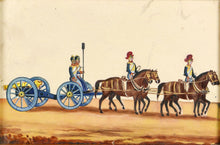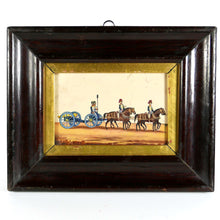An East India Company School Miniature of a Madras Horse Artillery Gun Team, 1830
- Regular price
- £2,200
- Sale price
- £2,200
- Regular price
-
- Unit price
- /per
Adding product to your cart
Overall: 22.5cm (8.8in) x 27.5cm (10.8n)
Gouache on mica. A four horse gun team of the Madras Horse Artillery with two European mounted drivers and two golundaz (Indian gunners) seated on the gun limber. Image: 10cm x 15cm. Contained in period ebonised frame with gilt slip. Glazed.
Read more
The ‘golundaz' (ball thrower) was named from the Persian words ‘gol’ meaning balls, and 'andakhtun' which means to throw. By the mid-1830s the East India Company's Madras Army had three battalions of artillery and one regiment of Horse Artillery on strength, with their headquarters at St Thomas Mount, Madras. The first recorded use of Horse Artillery was in 1756 when the H.E.I.C. formed a unit of Madras Galloper Guns that were faster and more mobile than the bullock and draft horse drawn guns and were able to keep up with cavalry. This unit became Horse Artillery when the 2nd Troop Madras Horse Artillery formed on 23 January 1809. Its modern descendant is J (Sidi Rezegh) Battery 3rd Regiment Royal Horse Artillery. The Rocket Troop Madras Horse Artillery was the 1st Troop formed in 1805. It became 'C' Troop Madras Horse Artillery in 1825, served in the 1st China War in 1840. Its modern descendant is P Battery (The Dragon Troop) 5th Regiment Royal Artillery. In 1862 the Madras Horse Artillery was taken into the British Army Royal Horse Artillery as the 3rd Royal Horse Artillery Brigade.
Company School of painting combined traditional elements of the Rajput and Mughal styles with Western treatment. It began as a form of portraiture in the 18th century, and by the early 19th century and was useful as in illustrating the dress and accoutrements of southern Indian trades and occupations to the expanding British military and civil populations. Company School paintings were for Britons reminders and souvenirs of service in India.






